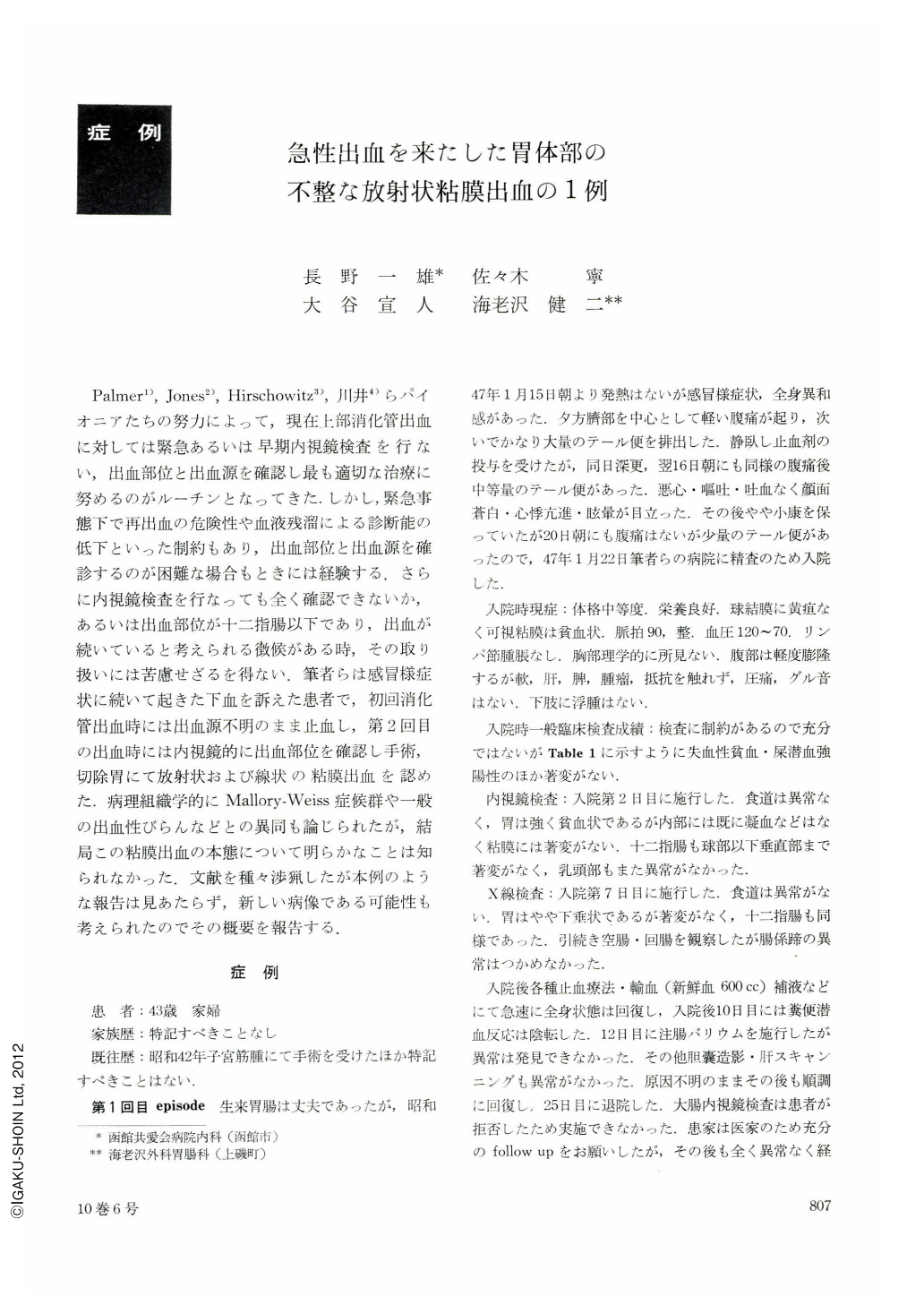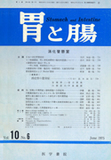Japanese
English
- 有料閲覧
- Abstract 文献概要
- 1ページ目 Look Inside
Palmer,Jones,Hirschowitz,川井らパイオニアたちの努力によって,現在上部消化管出血に対しては緊急あるいは早期内視鏡検査を行ない,出血部位と出血源を確認し最も適切な治療に努めるのがルーチンとなってきた.しかし,緊急事態下で再出血の危険性や血液残溜による診断能の低下といった制約もあり,出血部位と出血源を確診するのが困難な場合もときには経験する.さらに内視鏡検査を行なっても全く確認できないか,あるいは出血部位が十二指腸以下であり,出血が続いていると考えられる徴候がある時,その取り扱いには苦慮せざるを得ない.筆者らは感冒様症状に続いて起きた下血を訴えた患者で,初回消化管出血時には出血源不明のまま止血し,第2回目の出血時には内視鏡的に出血部位を確認し手術,切除胃にて放射状および線状の粘膜出血を認めた.病理組織学的にMallory-Weiss症候群や一般の出血性びらんなどとの異同も論じられたが,結局この粘膜出血の本態について明らかなことは知られなかった.文献を種々渉猟したが本例のような報告は見あたらず,新しい病像である可能性も考えられたのでその概要を報告する.
While urgent or early endoscopy is a routine method for the diagnosis of gastrointestinal hemorrhage at present, the site and source of bleeding are sometimes hard to locate. The authors have encountered a patient complaining of an episode of melena and brought about hemostasis although the source of bleeding remained obscure. In the second episode of bleeding its site was confirmed by early endoscopy and the patient was surgically treated. In the discussion of the resected stomach differentiation from Mallory-Weiss syndrome or common hemorrhagic erosion also presented some problems, but it was finally concluded that acute phlebitis of the submucosal layer must have been closely related with mucosal hemorrhage, although its essential mechanism was unknown. Since there has been no report in the literature such as this case and it may possibly become a new clinical entity, the outline is reported here.
The patient, a woman 43 years of age, with a past history of operation for uterine myoma, had the first episode of tarry stool along with common-cold-like symptoms from January 15, 1972. No abdominal pain, nausea or vomiting was experienced. On the 7 th day after hemorrhage she was admitted to the author's hospital. Endoscopy on the second day after admission and upper gastrointestinal series and barium enema examination on the 7 th day failed to reveal any remarkable changes. She got well, but the source of bleeding still remained obscure. She was discharged on the 25 th day. Her second episode of bleeding began on January 23, 1973, with continuous tarry stools and symptoms the same as were experienced in the previous year. She was readmitted on January 25. Endoscopy carried out on the third day revealed the site of bleeding in the corpus of the stomach. Since hematemesis and melena continued with aggravation of anemia due to bleeding, gastrectomy was performed.
The resected stomch showed 4 red stripes,1 mm wide and 4 cm long, rediating from the center of the anterior wall of the corpus. Their tips did not exceed the line of the lesser curvature. Near the terminal portions a dozen or so of stripes of similar nature all with a length less than 1 cm were found parallel to the longitudinal axis of the stomach. These lesions were not mucosal fissures but slight elevations like thin varices bleeding at various sites. Histologically, the mucosa of the corpus around the bleeding lesions was either normal or showed slight atrophic-hyperplastic gastritis. At the bleeding sites venules in the submucosal and subserosal layers wers dilated, with leukocytic infiltration mainly consisting of neutrophils around venular walls, giving a picture of acute phlebitis. Only in a limited area arterial intima was higly thickened. In these sites with manifest vascular lesions were found several mucosal, submucosal and subserosal hemorrhage. The hemorrhagic foci of the proper mucosal layer were accompanied by capillary dilatation, infiltration of neutrophilic leukocytes and hemorrhagic necrosis of the mucosal surface, but they were free from fibrinoid necrosis or covering of regenerative epithelss.

Copyright © 1975, Igaku-Shoin Ltd. All rights reserved.


